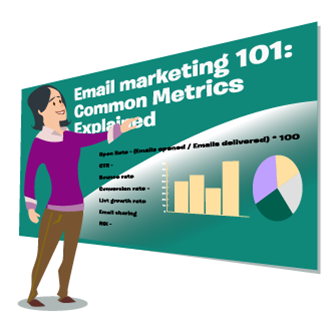Email marketing has more active users than all other social media channels combined, so it’s no surprise that it continues to be the most powerful digital marketing tool that you can access.
With its near limitless reach and vast potential, you want to track the right metrics, so you make sure that your email campaigns are doing as well as they can be.
In case you don’t know, there are over 30 billion e-mails are exchanged daily around the world.
E-mail has fundamentally changed the way people communicate, removed various barriers in writing, and enabled millions of people to participate in the dialogue in a fast and straightforward way.
Let’s take a step back to explain some of the basics. What is email marketing in its core?
Email marketing is one of the direct marketing channels that allow direct communication with the end customer/user using techniques such as email newsletters.
Why send it? Email outperforms all other promotional and communication channels just because they occupy the most attention of the person whom the email reads.
Also, it serves to maintain constant contact with existing or new customers about new service or product offerings, deals, discounts.
The fundamental advantages of email marketing
Email marketing as a means of direct marketing provides many benefits, and one of it is that email newsletter strengthens the position of the company and its products.
E-mail creates a two-way relationship with users and promotes long-lasting, qualitative relationships.
Since the user has already given his consent to receive company product information and services, company email messages are expected as messages from friends.
Further advantages? It is significantly cheaper and faster than the classic forms of direct communication such as mail, fax messages, phone calls, radio or TV.
Besides, email marketing is quick. The email newsletter in your subscriber’s “inbox” arrives in just a few seconds. In that way, users can respond immediately by returning an e-mail or by pushing a mouse on a link to a company’s web site to get more information there.
That is how the interaction between the company and its users is realised.
One of the benefits of email marketing, which is often forgotten, is that much can be measured and analysed, and results can be compared to the investment and performance of a marketing campaign.
E-mail marketing platforms offer the ability to measure the effectiveness of an e-mail campaign, whether open or unopened e-mail, number of clicks, subscriber number, number of users who have terminated their subscription.
This information provides valuable advice on the effectiveness of an email campaign, giving insight into what it is doing great and can lead to business growth, and what is wrong and what needs to be changed or removed.
The primary email metrics to look out for
There’s a lot to track and talk about when it comes to how to do email marketing right.
However, at the end of the day, it doesn’t matter how optimised or how good is your subject line if you don’t measure whether emails are helping you to hit your goals.
Even if your email campaign was perfect, if you don’t understand how to measure the results and which metrics to look at, it’s all for nothing.
Before even starting with your email marketing, you need to detect your goals, and afterward decide how to measure the success (or fail) of the campaign.
Whatever you decide that your goal is (grow subscriber data, generate more leads or convert those existing leads) there are some common metrics every marketer should learn and know how to track.
We will cover the most generally known which you should pay attention to your email marketing efforts.
1. Clickthrough Rate
Clickthrough rate is one of the most basic metrics you should track that tells you how well your campaigns are doing.
CTR measures how many users clicked on the links in your email, hence showing the engagement of your target audience.
For instance, if you included a link to your website that leads to the product page, the CTR measures what percentage of subscribers clicked on your links.
Clickthrough rate (CTR) is the primary thing to measure and probably the first answer you’ll hear when you ask your email campaign marketer what metrics they track.
It’s the “day-to-day” email marketing metric because it lets you quickly calculate performance for every individual email you send.
On that account, you can track how your CTR changes over time and quickly adapt to the results.
2. Conversion Rate
CTR tells you how many people have clicked on the links in your email, while conversion rate is the percentage of the number of email recipients who clicked on a link within an email and completed a specific action, such as filling out a subscription form or purchasing a product.
After an email subscriber has clicked through on your email, the next goal is to get them to convert on your offer. In simpler terms, it means to take the action that your email has asked them to take.
So, if you’re sending out an email to offer your audience the link to download, for example, a free e-book, you’d consider anyone who actually downloads that e-book to be a conversion.
Your definition of a conversion is straightly connected to the CTA (call-to-action) in your email, and your CTA should be directly tied to the overall goal of your email marketing.
That’s why the conversion rate is one of the most important metrics for determining the range to which you’re achieving your goals.
Conversion rates are a mandatory measure because it gives you unique insight into your ROI (return on investment).
3. Bounce Rate
Bounce rate refers to the percentage of your total emails sent that returned an error after being sent; they weren’t successfully delivered to the recipient.
There are two kinds of bounces to keep in mind: “hard” bounces and “soft” bounces. Soft bounces are temporary problems with an email address (full inbox) or with the recipient’s server. In these cases, delivery will follow if the issue is resolved.
On the other hand, hard bounces include an invalid, closed or non-existing email address, and these email newsletters will never be delivered.
Checking your bounce rates is necessary for ensuring that your email campaign delivers correct message.
In fact, high bounce rates may be a sign of a problem related to a specific email client or to the email service.
Hard bounce rates are often one of the crucial elements used by internet service providers (ISPs) to determine sender reputation.
Therefore, you should always regularly check and clean up your lists when such issues arise.
4. Open rate
Among numerous email statistics, open rate is one of the most straightforward email marketing metrics. Despite its simplicity, it is vital to understand how well your subscribers are receiving your newsletters.
Open rate tracks the number of emails opened compared to the total amount delivered. Open rate metric gives you the insight into the success of your subject line and preheader copy. That’s why you need to carry out test frequently and pay attention to which subject lines copy are working and which are don’t.
Unfortunately, your open rate is never 100% correct, but it can give you an overall idea of which and how many emails are being open.
As a guideline, most email campaigns have an average open rate of somewhere around 24%. If you manage a campaign with open rates higher than that, you know you are doing something right.
5. List growth rate
From those metrics such as CTR, conversion rates or open rates you also want to track your growth or loss list. List growth rate is a metric you need to follow when you want to check the rate which your list is growing.
It is an essential metric to follow because it extends your reach and extends your chance of subscribers engaging with your content.
By all means, you should aim to expand your list to enlarge your audience. It’s highly essential to have an idea of how many people are interested in your product, and it’s also important to measure how quick or slow your email list is declining or increasing.
Ask yourself this: did you notice a significant growth in your subscriber’s list? Try and identify this accomplishment; what content or topics work? Is this success related to other marketing activities?
Similarly, if you’re experiencing more subscriber drop-off than usual, think about your marketing strategy as a whole and try to analyse and change the perspective.
6. Email sharing/forwarding rate
Email sharing or forwarding rate is an excellent metric because it measures the percentage of the recipient who shared your post via social networks or forwarded it to someone else.
This rate can give you a complete idea of how much percent of subscribers are recommending your emails to other people – which is a valuable insight for numerous reasons: it allows you to know the range to which subscribers were engaged with your email content.
Also, with this metric, you can track your brand advocates, and through them, you can create new contacts. This way you generate new leads by encouraging your readers to share your email or forward it to a friend.
Keep a careful eye on your sharing rates to find out what type kind of content is likely to become the most popular among your readers, and use that insight in your next email campaigns.
7. Overall ROI
Last but not least..overall ROI! Yes, we know every email marketer should track this one. Why? It tells you the total return on investment for your campaigns. That means the total revenue divided by the total spend.
With tracking your ROI, you can accurately measure the cost-effectiveness of your email campaigns.
E-mail marketing can be a high investment, but it also has the highest ROI (400%) out of any other digital marketing strategy.
However, remember that “true cost” is sometimes difficult to define and varies from business to business, industry to industry.
That’s why we cannot emphasise more on the importance of using email marketing in your business.
How to calculate the common email marketing metrics
- Open Rate – (Emails opened / Emails delivered) * 100
- CTR – (Emails clicked / Emails delivered) * 100
- Bounce rate – (Returned emails / Sent emails) * 100
- Conversion rate – (Number of users who have completed the action / Emails delivered) * 100
- List growth rate – (Number of new subscribers) minus (Number of unsubscribes + email/spam complaints)] ÷ Total number of email addresses on your list]) * 100
- Email sharing – (Number of clicks on a share and/or forward button ÷ Number of total delivered emails) * 100
- ROI – [(Value of sales from an email campaign – Campaign costs) / Campaign costs] * 100
In conclusion
Email marketing is one of the most impressive and capable marketing tools out there.
The most important advantage of using e-mail marketing is the relatively low cost, speed, and ease of use, the ability to integrate with other marketing forms, the possibility of customer segmentation and personalisation of promotional activities.
With these advantages, one more significant feature – e-mail campaigns can be easily tracked and measured, with metrics like open rate, CTR, conversion rate, email sharing/forwarding, bounce rate, list growth rate and overall ROI.
Data monitoring and analysis are fundamental in assessing any marketing campaign, let alone in email marketing.
It is essential that you know the goal of your email marketing campaign and according to the goal that you measure an email campaign’s results.
When you set up aim, these metrics that we explained will help you measure your overall success as well as show you where to make necessary adjustments.







